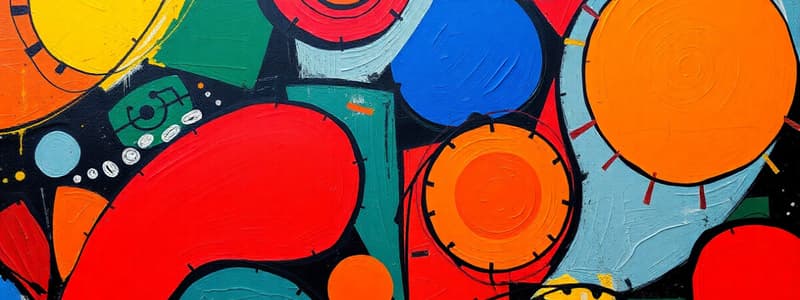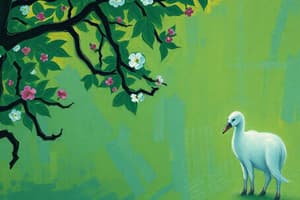Podcast
Questions and Answers
What are the four main categories of arts?
What are the four main categories of arts?
Visual arts, performing arts, literature, and music.
How does art function as a cultural reflection?
How does art function as a cultural reflection?
Art communicates societal values, beliefs, and history.
Name one key characteristic of the Impressionism movement.
Name one key characteristic of the Impressionism movement.
Focus on capturing light and momentary scenes.
What role does creativity play in the arts?
What role does creativity play in the arts?
Identify two functions of arts.
Identify two functions of arts.
What impact has technology had on the arts?
What impact has technology had on the arts?
Describe the Modernism movement in the context of the arts.
Describe the Modernism movement in the context of the arts.
What is meant by 'medium' in the context of arts?
What is meant by 'medium' in the context of arts?
Flashcards are hidden until you start studying
Study Notes
Definition of Arts
- Broadly encompasses various creative expressions.
- Includes visual arts, performing arts, literature, and music.
Types of Arts
-
Visual Arts
- Painting, sculpture, photography, and printmaking.
- Focus on aesthetics, design, and visual communication.
-
Performing Arts
- Theatre, dance, music, and opera.
- Involves live performance and audience engagement.
-
Literature
- Poetry, novels, essays, and plays.
- Explores themes, storytelling, and language.
-
Music
- Comprises various genres, styles, and cultural expressions.
- Integrates elements like melody, harmony, rhythm, and dynamics.
Functions of Arts
- Cultural Reflection: Communicates societal values, beliefs, and history.
- Emotional Expression: Conveys personal or collective feelings and experiences.
- Aesthetic Pleasure: Provides sensory enjoyment and appreciation.
- Social Critique: Challenges norms and provokes thought about social issues.
- Functional Role: Used in rituals, celebrations, and ceremonies.
Historical Context
- Arts have evolved across civilizations, reflecting changes in society.
- Movements include:
- Renaissance: Revival of classical learning and arts.
- Baroque: Dramatic and emotional expressions.
- Modernism: Breakaway from tradition; embraced innovation.
- Postmodernism: Challenges established narratives and ideas.
Key Concepts
- Creativity: Central to all forms of arts; involves originality and innovation.
- Medium: The materials or methods used to create art (e.g., oil paint, clay, digital).
- Style: Characteristic features defining a work or movement (e.g., impressionism, realism).
- Interpretation: Individual understanding of artistic works; subjective nature of art.
Influential Artistic Movements
- Impressionism: Focused on capturing light and momentary scenes.
- Cubism: Abstract form; broke subjects into geometric shapes.
- Surrealism: Explored dreamlike and irrational scenes.
- Abstract Expressionism: Prioritized spontaneous and expressive creation.
Impact of Technology
- Digital arts and new media have transformed the traditional arts landscape.
- Access to art has increased through online platforms and social media.
Art Criticism and Theory
- Involves analyzing and evaluating artworks.
- Critiques may focus on aesthetic value, technical skill, and cultural context.
Importance of Arts Education
- Encourages creativity, critical thinking, and cultural appreciation.
- Enhances emotional and social development.
Current Trends in Arts
- Increased focus on diversity and inclusion in artistic representation.
- Collaboration across disciplines and genres (e.g., art and technology).
- Environmental themes explored in response to global challenges.
Definition of Arts
- Arts are forms of creative expression that encompass a wide range of disciplines.
- Key areas include visual arts, performing arts, literature, and music.
Visual Arts
- Visual arts focus on aesthetics, design, and visual communication.
- Examples include painting, sculpture, photography, and printmaking.
Performing Arts
- Performing arts involve live performance and audience engagement.
- Examples include theatre, dance, music, and opera.
Literature
- Literature explores themes, storytelling, and language.
- Examples include poetry, novels, essays, and plays.
Music
- Music encompasses various genres, styles, and cultural expressions.
- Includes elements like melody, harmony, rhythm, and dynamics.
Functions of Arts
- Arts reflect societal values, beliefs, and history.
- Arts express personal or collective feelings and experiences.
- Arts provide sensory enjoyment and appreciation.
- Arts challenge norms and provoke thought about social issues.
- Arts are used in rituals, celebrations, and ceremonies.
Historical Context
- Arts have evolved with different civilizations, reflecting social change.
- Major movements include Renaissance, Baroque, Modernism, and Postmodernism.
Key Concepts
- Creativity is central to all arts, involving originality and innovation.
- Medium refers to the materials or methods used to create art.
- Style denotes characteristic features that define a work or movement.
- Interpretation refers to individual understanding of artistic works.
Influential Artistic Movements
- Impressionism focused on capturing light and momentary scenes.
- Cubism broke subjects into geometric shapes, creating abstract form.
- Surrealism explored dreamlike and irrational scenes.
- Abstract Expressionism prioritized spontaneous and expressive creation.
Impact of Technology
- Digital arts and new media have transformed traditional art forms.
- Online platforms and social media have increased access to art.
Art Criticism and Theory
- Art criticism involves analyzing and evaluating artworks.
- Critiques can focus on aesthetic value, technical skill, and cultural context.
Importance of Arts Education
- Arts education encourages creativity, critical thinking, and cultural appreciation.
- Arts education enhances emotional and social development.
Current Trends in Arts
- Increased focus on diversity and inclusion within artistic representation.
- Collaboration between disciplines and genres (e.g., art and technology).
- Environmental themes explored in response to global challenges.
Studying That Suits You
Use AI to generate personalized quizzes and flashcards to suit your learning preferences.




